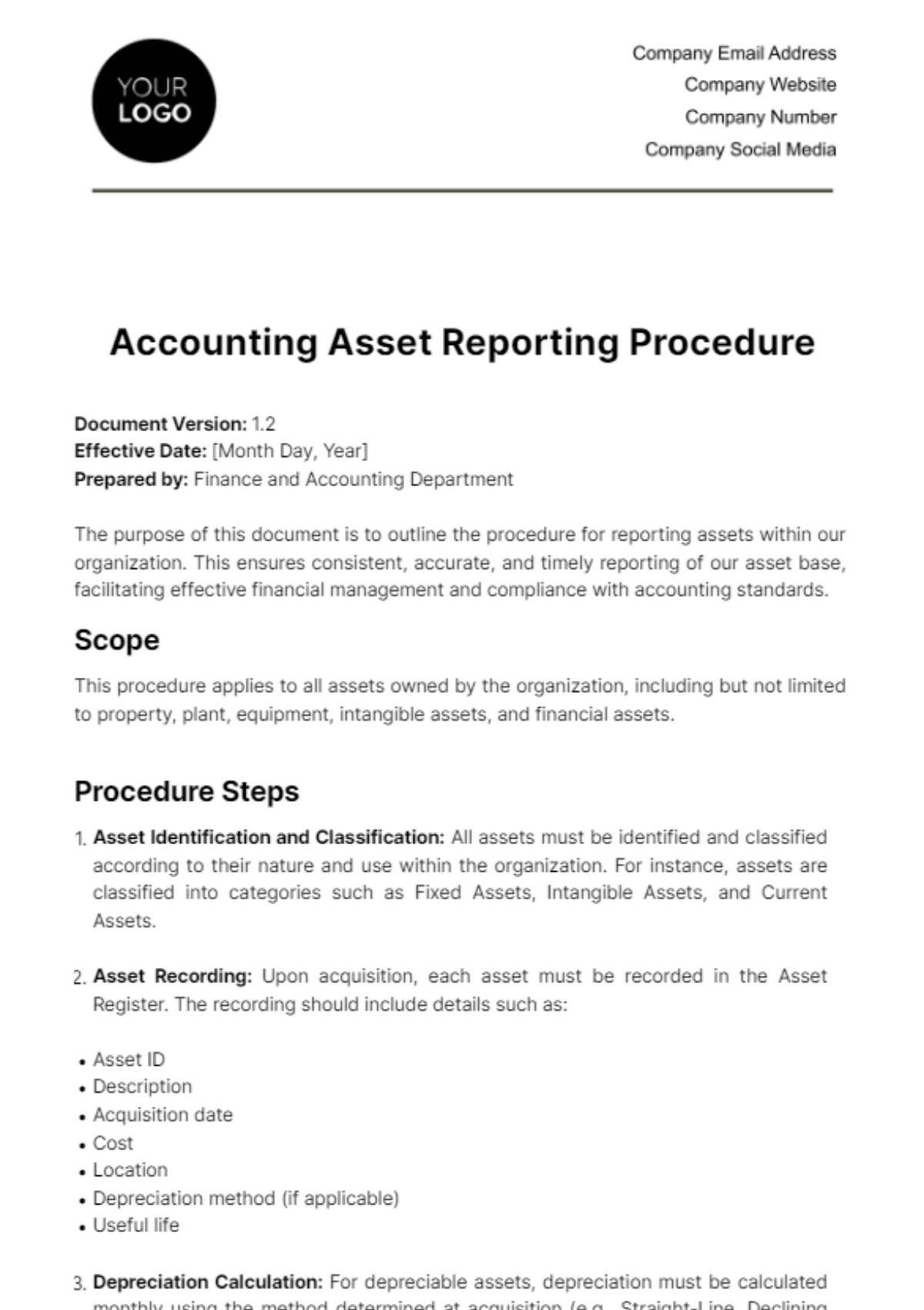Accounting Asset Reporting Procedure
Document Version: 1.2
Effective Date: [Month Day, Year]
Prepared by: Finance and Accounting Department
The purpose of this document is to outline the procedure for reporting assets within our organization. This ensures consistent, accurate, and timely reporting of our asset base, facilitating effective financial management and compliance with accounting standards.
Scope
This procedure applies to all assets owned by the organization, including but not limited to property, plant, equipment, intangible assets, and financial assets.
Procedure Steps
Asset Identification and Classification: All assets must be identified and classified according to their nature and use within the organization. For instance, assets are classified into categories such as Fixed Assets, Intangible Assets, and Current Assets.
Asset Recording: Upon acquisition, each asset must be recorded in the Asset Register. The recording should include details such as:
Depreciation Calculation: For depreciable assets, depreciation must be calculated monthly using the method determined at acquisition (e.g., Straight-Line, Declining Balance). For example, a computer with a cost of $1,200, a useful life of 3 years, and no salvage value would be depreciated at $33.33 per month under the Straight-Line method.
Asset Revaluation: If applicable, assets must be revalued annually to reflect fair market value, particularly for significant assets where market conditions may substantially affect their value. This may involve external appraisals.
Asset Disposal Reporting: Upon disposal of an asset, the Asset Register must be updated to reflect this change. The report should include the disposal date, method (e.g., sale, scrap), and any gain or loss on disposal. For example, if a vehicle initially costing $20,000 and with accumulated depreciation of $15,000 is sold for $6,000, a gain of $1,000 should be reported.
Monthly Reporting
A monthly asset report must be prepared and submitted to the Finance Department. This report should summarize:
Additions and disposals during the period
Depreciation expense for the period
Any revaluations or impairments
The net book value of assets
Annual Asset Review
An annual review of all assets must be conducted to verify their existence, condition, and valuation. This may involve physical inspections and a review of depreciation policies to ensure they reflect the assets' useful lives accurately.
Responsibilities
Finance and Accounting Department: Responsible for the overall management of the asset reporting process, including maintaining the Asset Register, calculating depreciation, and preparing monthly and annual reports.
Department Heads: Responsible for verifying the existence and condition of assets within their departments and reporting any discrepancies or changes in asset status to the Finance and Accounting Department.
Documentation
All asset transactions and adjustments must be adequately documented, including purchase invoices, disposal receipts, depreciation schedules, and revaluation reports.
Compliance
This procedure is designed to ensure compliance with accounting standards such as IFRS and GAAP, as applicable, and internal policies regarding asset management.
Review and Updates
This procedure will be reviewed annually or as needed to reflect changes in accounting standards, operational needs, or asset base.
Approval
[Signature of CFO]
Chief Financial Officer
[Date]
Accounting Templates @ Template.net






























